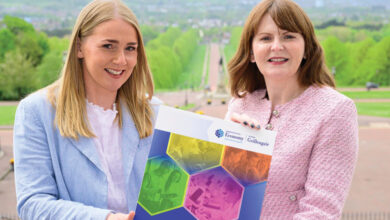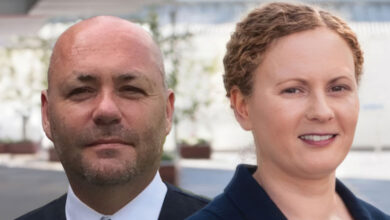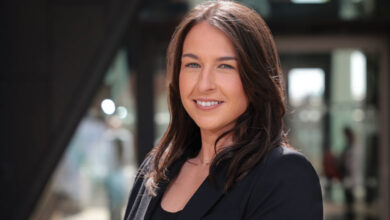What does the future of sound like?
 Mark Mahaffy, Regional Managing Director of Cool FM and Downtown Radio, looked at the future prospects for radio at agendaNi’s digital media seminar. Fiona McQuade reports.
Mark Mahaffy, Regional Managing Director of Cool FM and Downtown Radio, looked at the future prospects for radio at agendaNi’s digital media seminar. Fiona McQuade reports.
Downtown was established 37 years ago and was the first commercial radio station in Northern Ireland. Over the past few years radio has found itself having to adapt to a new digital era. There have been rapid seismic changes in media consumption in the past decade. Mahaffy described the difficult process of adapting traditional radio to new technology as similar to ‘pushing water up a hill’. However, he believes commercial digital radio is in its infancy.
Cool FM and Downtown are now DAB stations, two out of a total of 22 DAB stations in Northern Ireland. Mahaffy contradicts the song ‘Video Killed the Radio Star’ by arguing that new technology doesn’t threaten radio; instead it widens its audience as it can reach listeners through a number of different platforms. Nine out of ten adults in Northern Ireland listen to radio weekly, of whom Cool FM has a reach of 408,000 listeners. The latest audience figures show growth and Cool FM now reaches 95 per cent of the 15-34 target age group over a period of 13 weeks.
DAB radio
Ownership of a digital DAB radio has tripled in the past decade. However, Mahaffy points out that ownership of DAB radios in Northern Ireland is currently at 26 per cent, which is much lower in comparison to England, Scotland and Wales which are edging towards 50 per cent of all homes owning a DAB radio. This brings the total of DAB listeners in the UK to 29.9 per cent. The Government’s plan to switch-over to DAB radio in 2015 is now seeming unlikely. There has been some criticism that DAB is not yet at the same standard as FM radio. Mahaffy observes that the Northern Ireland figures of DAB ownership are not growing quickly enough thus he believes FM is safe for another few years. Despite this, Mahaffy stated that “radio’s future is digital, and it is multi-platform.”
Radio is no longer confined simply to the car or home. Audiences choosing to tune into radio shows via the internet have increased from 3 per cent to 10 per cent. Listeners can even watch the presenters via webcam. Mahaffy believes that new technology enhances radio and increases its reach. He drew attention to Apple’s introduction of an FM receiver in its fifth generation iPod. The technological advances in smart phones have been revolutionary for the radio industry as listeners can tune in on the go. The biggest adopters of radio listening via mobile phones are 15-19 year olds.
Discovering new music is the core driver for audiences tuning in. Radio still remains the best source for discovering new music, above friends and gigs, with 74 per cent of people stating that it is their main method of discovery. Mahaffy states that 48 per cent of those who consciously strive to discover new music purchase the music physically after hearing it. In 2012, adults spent 22 per cent of their hours spent interacting with media listening to the radio. This figure has remained steady for the past three years. TV still takes the biggest share at 44 per cent but time spent watching it has decreased as usage of the internet has increased.
A recent poll found that radio still comes top against other music sources for being entertaining, inspiring, relaxing and keeping the audience up to date. Radio remains number one in influencing musical choice as 52 per cent of people claim it is the main influence in shaping their taste in music. Mahaffy firmly believes that audiences still prefer a live medium, with 97.5 per cent of listeners tuning in to radio shows live and 88 per cent of TV viewers still watching shows live.
Social media
Mahaffy also states that radio is naturally at home in social media. Both are instantaneous and conversational, providing interesting and engaging content. Cool FM has achieved 175,000 app downloads and 99,000 likes on facebook. Social media enables radio to connect with listeners beyond the airwaves, creating excitement and interaction around their brand and music. Using technology, radio has found new ways to engage listeners and strengthen relationships with them. It is important to shape social media content not to just broadcast but to create a conversation. Mahaffy remarks: “Social has always been a part of our DNA.”
However, Mahaffy points out that time spent with traditional broadcast media still dwarfs social media. In the typical UK month, 4,149 million hours are spent listening to radio whilst only 178 million hours are spent on facebook and just
2 million hours are spent on twitter. People spend 20 times longer listening to radio than they do on facebook. Social media may be on the march, but he believes that traditional media is still holding its own.
Digital future
Mahaffy predicts the future for radio: “without a doubt, it’s digital”. He states that the advancement of internet speeds and technology can only be a good thing for radio, for instance BT’s plan to expand fibre optic broadband across 66 per cent of the UK by 2015. The prospect of 4G internet for mobile phones could increase data speeds by nine times and enable better access.
There has been a lot of change since the station’s early beginnings with more entertainment and choice for listeners. Radio has been radically transformed by the progress of technology and it is hard to know how it may evolve and what it will look like in the future.
In Mahaffy’s view, the tablet is the one to watch. He believes that design and innovation will continue to drive the sector forward, calling it ‘The New World’. Mahaffy shares that there is a greater opportunity for the radio industry to deliver new services and content opportunities to consumers via multi-platforms. In closing, he quotes the Radio Advertising Bureau in stating: “The future of radio isn’t FM or DAB or internet – it’s all of them, working together seamlessly.”





